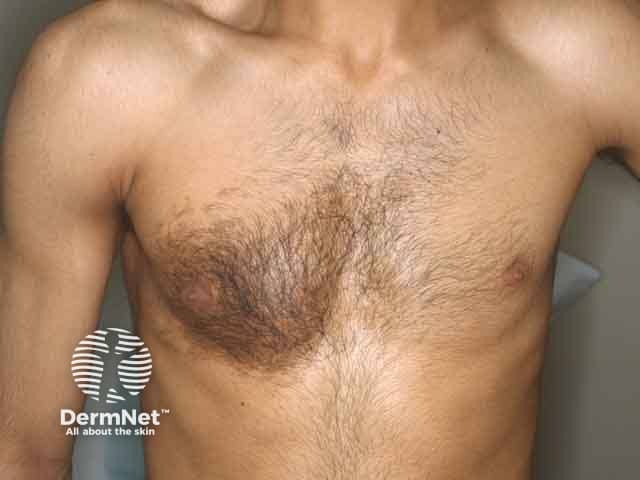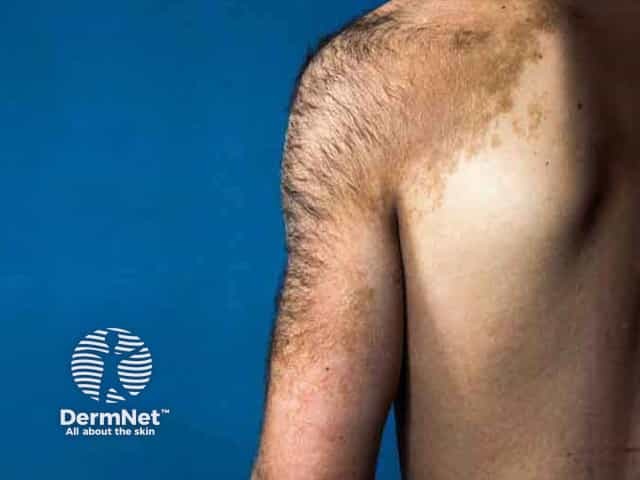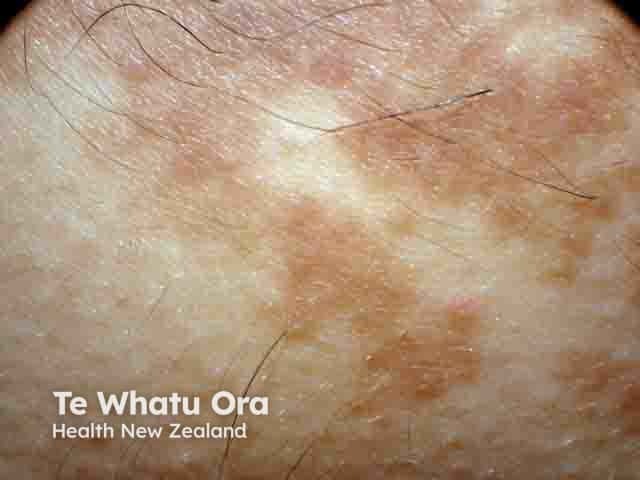Main menu
Common skin conditions

NEWS
Join DermNet PRO
Read more
Quick links
Becker naevus — extra information
Becker naevus
Author(s): Nikhil Dwivedi, Faculty of Health Sciences and Medicine, Bond University, Australia. Copy edited by Gus Mitchell. July 2022.
Introduction Demographics Causes Clinical features Variation in skin types Complications Diagnosis Differential diagnoses Treatment Prevention Outcome
What is Becker naevus?
A Becker naevus (nevus in American English) is a late-onset epidermal naevus or birthmark characterised by a large brown patch and occurs mostly in males.
Also referred to as Becker melanosis and Becker pigmentary hamartoma, it is an overgrowth of the epidermis (upper layers of the skin), pigment cells (melanocytes), and hair follicles. It develops during childhood or adolescence, usually on the shoulders or upper trunk but occasionally found elsewhere.

Hyperpigmentation and hypertrichosis over the chest in Becker naevus

Pigmentation and hypertrichosis in Becker naevus (BN-patient3)

Close-up of Becker naevus showing pigmentation and hypertrichosis (BN-patient4)
Who gets Becker naevus?
- More common in males with an incidence ratio of 5:1
- Estimated prevalence among males is 0.5%
- Can occur in all skin types
- Usually presents in the second or third decade of life
What causes Becker naevus?
While the exact aetiology is unknown, it is thought that a currently unidentified gene defect may be the cause. Its development may be triggered by circulating androgens (such as testosterone), which may explain why it appears in males at puberty.
Becker melanosis is not known to be hereditary and does not typically run in families, however, there are some reports of multiple family members being affected.
What are the clinical features of Becker naevus?
Features include:
- A large one-sided well-defined brown patch
- Usually on the shoulder or upper trunk
- Sometimes over half the upper back or chest
- Skin can appear to be slightly thickened
- After puberty, it often becomes darker and quite hairy (hypertrichosis)
- Occasionally, acne may develop in the naevus.
Rarely, like other birthmarks, there may be some abnormality of underlying tissues derived from the same embryonic cell type, the ectoderm. This is known as the Becker naevus syndrome, a type of epidermal naevus syndrome. These abnormalities may include:
- Smooth muscle hamartoma
- Under-development of underlying structures such as breast, pectoral muscle, fat, limb, chest wall, and spine
- Over-development of tissues such as adrenal glands, limbs, fingers or toes, or scrotum.
How do clinical features vary in differing types of skin?
In darker skin phenotypes, the naevus can appear darker and leathery.
What are the complications of Becker naevus?
- Becker naevus syndrome (see above)
- Cosmetic disfigurement
- Psychological distress
How is Becker naevus diagnosed?
It is predominantly a clinical diagnosis based on clinical history and examining the lesion. It may be necessary to undertake a biopsy so that a Becker naevus can be differentiated from a café-au-lait macule.
What is the differential diagnosis for Becker naevus?
What is the treatment for Becker naevus?
There is no effective treatment for the majority of Becker naevi. However, there are some strategies to minimise the appearance and treat complications.
General measures
- The dark brown colour is less obvious if the affected area is kept out of the sun.
- Pigmentation may be improved by using camouflage make-up.
- Hair removal on a Becker’s naevus can be safely completed using techniques such as waxing, shaving, threading, and epilation creams. These methods will not increase the hair growth on the naevus.
Specific measures
- Excessive hairs can be reduced using a course of laser hair removal or by electrolysis.
- The pigmentation can be reduced by pigment laser treatment. This is not always effective and may worsen pigmentation.
- In severe cases, Becker naevus-associated acne can be treated with standard acne therapies, which may include oral isotretinoin.
How do you prevent Becker naevus?
No prevention strategies currently exist.
What is the outcome for Becker naevus?
The Becker naevus cannot be removed, however, the cosmetic appearance and complications, such as acne, may be improved. There are no current reports of Becker naevi undergoing malignant changes.
Bibliography
- Alfaro A, Torrelo A, Hernández A, Zambrano A, Happle R. Síndrome del nevo de Becker [Becker nevus syndrome]. Actas Dermosifiliogr. 2007;98(9):624–626. Journal
- Cai ED, Sun BK, Chiang A, et al. Postzygotic Mutations in Beta-Actin Are Associated with Becker's Nevus and Becker's Nevus Syndrome. J Invest Dermatol. 2017;137(8):1795-1798. doi:10.1016/j.jid.2017.03.017. Journal
- Dasegowda SB, Basavaraj G, Nischal K, Swaroop M, Umashankar N, Swamy SS. Becker's Nevus Syndrome. Indian J Dermatol. 2014;59(4):421. doi:10.4103/0019-5154.135530. Journal
- Kaliyadan F, Ashique KT. Becker Melanosis. In: StatPearls. Treasure Island (FL): StatPearls Publishing; September 14, 2021. PubMed
- Schäfer K, Bauer B, Donhauser J, Kerstan A, Hamm H. Becker Naevus Syndrome of the Lower Body: One Case and Review of the Literature. Acta Derm Venereol. 2017;97(4):499–504. doi:10.2340/00015555-2589. Journal
On DermNet
- Acne
- Becker naevus images
- Birthmarks
- Epidermal naevi
- Inflammatory linear verrucous naevus
- Comedone naevus
- Sebaceous naevus
- Linear porokeratosis
Other websites
- Becker's naevus — British Association of Dermatologists
- Becker’s naevus — The Australasian College of Dermatologists
